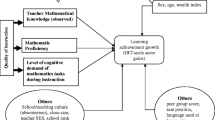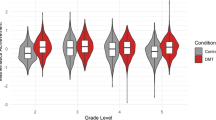Abstract
The main purpose of this study was to analyse how pupils, differing in achievement levels in mathematics, performed operations with numbers and solved mathematical problems. What strategies did they use in different grades when they performed the operations and solved the problems correctly, and what types of errors were involved when they solved an item incorrectly? What types of errors disappear and what types of errors remain at a later grade? Five groups of pupils, comprising a total number of 900, who have shown different developments in mathematical achievement from grades 3 to 6 have been studied. When the pupils solved items correctly they used the same strategies irrespective of their total results. However, when they made errors they used a number of different strategies. The results of this study implicate that it is very essential that the teaching be individualised and built upon how the pupils think when solving mathematical problems.
Similar content being viewed by others
References
Brown, J. S. and vanLehn, K.: 1982, ‘Towards a generative theory of “bugs”’, in Carpenter, T. P. et al. (eds.), Addition and Subtraction: A Cognitive Perspective, Lawrence Erlbaum Associates, New Jersey.
Brueckner, L. J. and Elwell, M.: 1945, ‘Reliability of diagnosis of error in multiplication of fractions’, Journal of Educational Research 26, 175–185.
Cox, L. S.: 1975a, ‘Diagnosing and remediating systematic errors in addition and subtraction computations’, Arithmetic Teacher 22, 151–157.
Cox, L. S.: 1975b, ‘Systematic errors in the four vertical algorithms in normal and handicapped populations’, Journal for Research in Mathematics Education 62, 202–220.
Fischbein, S.: 1970, Skolprestationer och yrkesval i årskurs 9 i relation till olika bakgrundsfaktorer. En analys av svenska data hämtade från IEA:s matematikundersökning, Lärarhögskolan. Pedagogisk-psykologiska insitutionen.
Fuson, K. C.: 1986, ‘Role of representation and verbalisation in the teaching of multidigit, addition and subtraction’, European Journal of Psychology of Education 1(2), 35–56.
Lundman, L.: 1979, Socioekonomisk differentiering i grundskolan, Gleerup, Lund.
Magne, O.: 1967, Matematiksvårigheter hos barn i åldern 7–13 år, Pedagogiska skrifter 241, Svensk lärartidnings förlag, Stockholm.
Magne, O. and Thörn, K.: 1987a, En kognitiv taxonomi för matematikundervisingen: Del 1. Undersökningar, Rapport nr 471, Institutionen för pedagogik, Lärarhögskolan i Malmö, Malmö.
Magne, O. and Thörn, K.: 1987b, En kognitiv taxonomi för matematikundervisning: Del 2. Analyser av huvudområden, Rapport nr 472, Institutionen för pedagogik, Lärarhögskolan i Malmö, Malmö.
Morton, R. L.: 1924, ‘An analysis of pupils errors in fractions’, Journal of Educational Research 10, 117–125.
Munck, I.: 1979, Model Building in Comparative Education. Applications of the LISREL Method to Cross-National Survey Data, Institute of International Education. University of Stockholm, Stockholm.
Pettersson, A.: 1990, Att utvecklas i matematik, En studie av elever med olika prestation-sutveckling, Almqwist & Wiksell International, Stockholm.
Resnick, L. B.: 1983, ‘A developmental theory of number understanding’, in Ginsburg, H. P. (ed.), The Development of Mathematical Thinking, Academic Press, New York.
Resnick, L. B. and Ford, W. W.: 1981, The Psychology of Mathematics for Instruction, Lawrence Erlbaum Associates, New Jersey.
Roberts, G. H.: 1968, ‘The failure strategies of third grade arithmetic pupils’, Arithmetic Teacher 15, 442–446.
Saxe, G. B. and Posner, J.: 1983, ‘The development of numerical cognition: Cross-cultural perspectives’, in Ginsburg, H. P. (ed.), The Development of Mathematical Thinking, Acadmeic Press, New York.
West, T. A.: 1971, ‘Diagnosing pupil errors’, Arithmetic Teacher 18, 467–469.
Author information
Authors and Affiliations
Rights and permissions
About this article
Cite this article
Pettersson, A. Pupils' mathematical performance in grades 3 and 6. A longitudinal study. Educ Stud Math 22, 439–450 (1991). https://doi.org/10.1007/BF00367907
Issue Date:
DOI: https://doi.org/10.1007/BF00367907




